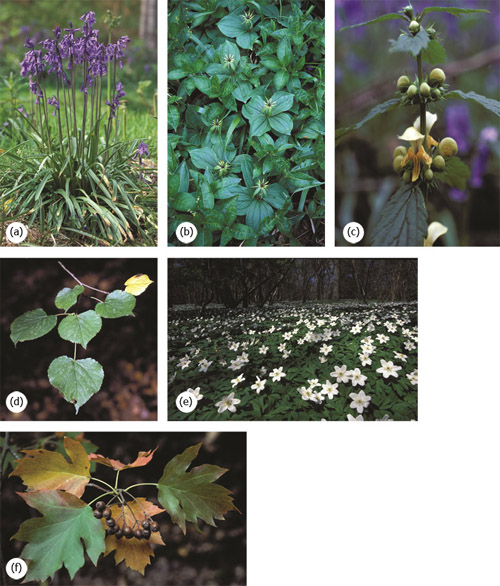1.4 Ancient woodland
The classic image of ancient woodland is probably an oak wood in southern England, with swathes of bluebells and other flowers, as seen in Archer's Wood. However, ancient woods across the UK come in many shapes and forms, from the remnants of Scottish native pinewoods, home of the capercaillie (Tetrao urogallus), to the oak and hazelwoods of the western Atlantic seaboard, characterised by lush growth of ferns, mosses and lichens.
The ancient woodland habitat has had centuries to develop and generally hosts a greater number of species than more recent woods – especially rare or localised species. It is considered an irreplaceable habitat – the UK's equivalent of the rainforest – by conservationists.
Determining whether a wood is ancient is like piecing together a jigsaw puzzle. Old maps and documents may provide strong evidence, as can the wood's name, but there are also clues in the wood itself. Historical features (e.g. medieval wood banks, old coppice stools and remnant field boundaries) tell of past land use, and the species that are found in the wood may also indicate antiquity.
The presence of certain indicator species is evidence of ancient woodland. Generally, 'ancient woodland indicators' are species that do not colonise new areas easily. Recall the presence of saproxylic beetles in Sherwood Forest, which are good indicators because of their poor powers of dispersal. However, flowering plants are most often used because they are easy to identify. They should be used with caution, though, as one plant may behave differently in different parts of the country (for example, in the north of England bluebells are not always restricted to woodland). Generally, it is not enough to find one 'indicator'; a number of plants from a list appropriate for that region is needed, and this should be used in conjunction with other evidence.
In the south of the UK, plants such as the bluebell (the native species Hyacinthoides non-scripta), wood anemone, herb paris (Paris quadrifolia) and yellow archangel (Lamiastrum galeobdolon) can act as ancient woodland indicators (Figure 4).

Question 2
In the 'Archer's Wood' clip, which species are identified as indicators of ancient woodland?
Answer
Wild service tree (Sorbus torminalis), bluebells and pendular sedge (Carex pendula).
In northern parts of the UK, though, mosses, liverworts and lichens may be better, since many of the southern indicators appear to live equally happily in open habitats in the north.
Trees that may indicate ancient woodland include the wild service and the smallleaved lime (Tilia cordata), which reproduce mainly by suckering (producing new shoots directly from the tree's root system) because the current climate is too cold for reliable seed production.
Today, ancient woods cover only around 2 per cent of the UK and are often small, isolated fragments. Online maps are available to help you to find out if any of your local woods are ancient.
Ancient woodland is under threat as most ancient woods are not in legally protected areas such as historic parks, landscapes and Sites of Special Scientific Interest. Although planning policy is more sympathetic now than in the past, policy makers still allow clearance for developments such as new roads or airports. Ancient woodland may also suffer indirect damage such as pollution from intensive farming.
During the twentieth century, 29 per cent of the ancient woodland in the UK was cleared and replanted with conifers. Remnants of the unique communities of animals and plants remain, but conservationists are concerned they will be lost if these woods are not restored by gradual removal of the conifers, allowing native species to regrow.
